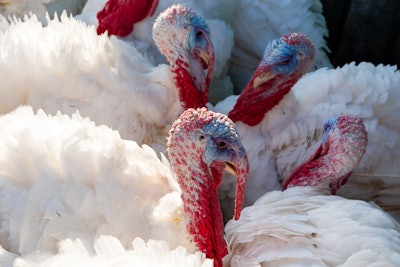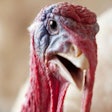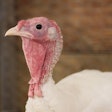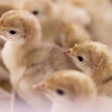
Tom turkeys raised to be deboned are commonly marketed at liveweights of 40-50 pounds (18.18-22.72 kilograms) in the U.S and Canada. These market weights are roughly 50% greater than 40 years ago. Most turkey hens are still raised for producing whole birds and are marketed at liveweights similar to historical norms (12-16 pounds or 5.45-7.27 kilograms).
Much of the university research of the impact of housing density on turkey performance, health and welfare goes back several decades. Since these studies were conducted, there have been considerable changes in bird genetics, housing, equipment and husbandry schemes.
The Canadian Codes of Practice are one of several widely used welfare schemes for raising turkeys, and the current allowable kilograms per square meter is 65 for heavy toms, which is significantly higher than the levels allowed for Certified Humane and the Global Animal Partnership (GAP). Karen Schwean-Lardner, Ph.D., associate professor, department of animal and poultry science, University of Saskatchewan, told the audience at PEAK 2023 that she and her colleagues were asked to conduct research to assess the effects of stocking density on the productivity, health and welfare of turkeys to inform any possible changes in the Canadian Codes of Practice.
Experimental design
Two studies were conducted with two trials each. In the first study, toms were raised to 16 weeks of age, and in the second, hens were raised to 11 weeks. In both studies, the birds were placed single stage in independently controlled rooms with 67.5 square meters of floor space (726.6 square feet). The number of birds in treatment groups were established so that, at the end of the study, the four treatment groups would have stocking densities of 30, 40, 50 and 60 kilograms of live turkeys per square meter (6.14, 8.19, 10.24 and 12.29 pounds per square foot).
Feeder and drinker space, as well as environmental enrichments, were adjusted to be equal on a per bird basis in all the treatment groups. A standard temperature curve was adhered to in the rooms, and 18 hours of light and six hours of darkness were provided each day. Straw was used for bedding, and straw bales were used for enrichment.
The carbon dioxide level in the rooms was measured three times per week, and ventilation rates were adjusted when differences between the rooms exceeded 20%. Ammonia levels were measured twice per week and ventilation rates were adjusted when difference between the rooms exceeded five parts per million.
 The highest level of aggressive mortality for hens was found at the treatment group housed at the lowest density, but infectious mortality was highest at the highest density.shcherbak volodymy | iStock.com
The highest level of aggressive mortality for hens was found at the treatment group housed at the lowest density, but infectious mortality was highest at the highest density.shcherbak volodymy | iStock.com
Impact of stocking density
In these experiments, increasing the stocking density had negative impacts on the feed conversion ratio, rate of weight gain, gait scores and feather coverage. There was no significant impact of increasing density on bird mortality found in this study. The biggest impact on body weight gain was found when density was increased from 50 to 60 kilograms per square meter (from 10.25 to 12.3 pounds per square foot).
Hens housed at the lowest density had the highest level of aggression mortality, but the highest level of infectious mortality in hens was found at the highest stocking density. For toms, the highest levels of aggression mortality were at the lowest density and next highest level was at the highest density.
Higher footpad lesion scores were found at higher densities – even with higher ventilation rates for these rooms. Gait scores were poorer at higher densities.
Future husbandry schemes
Broilers have been placed all-in all-out on single age farms in the U.S. and Canada for decades because of the relatively short time to market, sometimes as little as 35 days. Traditionally, turkeys in the U.S. and Canada were placed on multi-age farms to maximize pounds produced per square foot of housing. The extreme examples of this were three-age three-stage and two-stage three-age schemes, which have largely been abandoned as the health issues these schemes perpetuated on some farms offset any advantages gained from more fully utilizing the square footage in the turkey houses throughout the life of the flocks.
Most turkey operations in the U.S. which specialize in raising heavy toms now utilize single-age farms. The brooder farm houses the poults for five weeks, and then the birds are moved to a finisher farm where they remain until reaching market weight. These brood and move farms function like the old two-stage three-age farm, meaning one brooder farm provides birds for two finisher farms, while minimizing carryover of disease organisms from one flock to another. The cost of moving the birds from one farm to another is more than offset by the improved performance of the birds due to a lesser disease challenge.
Most hens are still raised on two-age two-stage farms. Heavy hens which are raised to produce processed whole birds in the 16 to 24-pound range might benefit from being raised brood and move in a similar manner as heavy toms, as long as the catching and moving process does not significantly negatively impact grade.
If the market weight of heavy toms continues to increase and welfare schemes dictate lower stocking densities, then producers will have to balance the benefits of processing heavier birds per shackle and higher breast meat yield versus a potential reduction in annual pounds produced per square foot of turkey house.
















